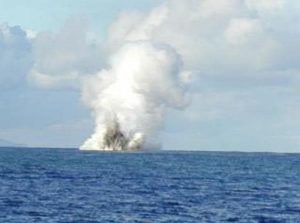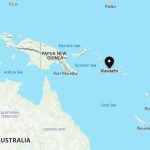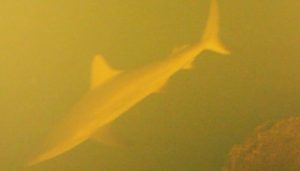 I realize that many people, me included, would have no desire to explore the inside of a volcano, but for scientists of volcanos…volcanologists, it is somehow important. A dormant volcano would be fairly easy to explore. There is less chance of getting caught in an eruption, but for one that isn’t dormant, it isn’t so easy. I don’t think I would want to try to explore Kilauea, because…well, it goes up all the time. Another very active volcano, Kavachi is not only active, but it is underwater. Kavachi is located in the south-west Pacific Ocean, south of Vangunu Island in the Solomon Islands. and is referred to locally as Rejo te Kavachi, meaning “Kavachi’s oven.” Kavachi has become active and then eroded back into the sea at least eight times since its first recorded eruption in 1939.
I realize that many people, me included, would have no desire to explore the inside of a volcano, but for scientists of volcanos…volcanologists, it is somehow important. A dormant volcano would be fairly easy to explore. There is less chance of getting caught in an eruption, but for one that isn’t dormant, it isn’t so easy. I don’t think I would want to try to explore Kilauea, because…well, it goes up all the time. Another very active volcano, Kavachi is not only active, but it is underwater. Kavachi is located in the south-west Pacific Ocean, south of Vangunu Island in the Solomon Islands. and is referred to locally as Rejo te Kavachi, meaning “Kavachi’s oven.” Kavachi has become active and then eroded back into the sea at least eight times since its first recorded eruption in 1939.
It is very strange to me to see pictures and videos of volcano erupting in the middle of the ocean. It seems so unnatural that fire and water could mix and the water not put out the fire. It’s a strange concept, but one that has baffled me for years. I think that the thought of fire and water has maybe been the curiosity behind the exploration of these underwater volcanoes. In May 2000, an international research team aboard the CSIRO  research vessel Franklin fixed the Kavachi volcano at 8° 59.65’S, 157° 58.23’E. The vent of the volcano was below sea level, but frequent eruptions ejected molten lava up to 230 feet above sea level, and sulfurous steam plumes up to 1,600 feet. The team mapped a roughly conical feature rising from 3,600 feet water depth, with the volcano having a basal diameter of about 5.0 miles. Of course, underwater volcanoes were the foundation of the Hawaiian Islands, so it is not a odd idea that when the Kavachi volcano erupted in 2003, a 49-foot island formed above the surface. The small island disappeared a short time later, so I suppose the volcano would have to erupt almost constantly in order to form an island that would last.
research vessel Franklin fixed the Kavachi volcano at 8° 59.65’S, 157° 58.23’E. The vent of the volcano was below sea level, but frequent eruptions ejected molten lava up to 230 feet above sea level, and sulfurous steam plumes up to 1,600 feet. The team mapped a roughly conical feature rising from 3,600 feet water depth, with the volcano having a basal diameter of about 5.0 miles. Of course, underwater volcanoes were the foundation of the Hawaiian Islands, so it is not a odd idea that when the Kavachi volcano erupted in 2003, a 49-foot island formed above the surface. The small island disappeared a short time later, so I suppose the volcano would have to erupt almost constantly in order to form an island that would last.
Of course, that strangest thing about Kavachi is that while the volcano is quite active, it has another strange anomaly to it. In 2015, marine life has been found living inside the Kavachi crater, including two species of sharks and a sixgill stingray. It seems so strange that they could live in an environment that must be quite acidic. The scientists haven’t been able to go in and explore yet, because of the possibility of an eruption.  Finally they took a chance and dropped a camera into the volcano. Concerned about activity from the volcano, the expedition members only left the camera in the hot, acidic water around the volcano for about an hour. Still, it was all they needed to find the wildlife inside. Of course, during an eruption, there is no way this marine life could live inside the volcano. That makes me wonder if they somehow know the eruption is coming so they can get out, or do they simply die when an eruption occurs. That somehow doesn’t seem like the case, because eventually there would be no more marine life in the volcano. I guess that is just a question we will probably never have an answer to.
Finally they took a chance and dropped a camera into the volcano. Concerned about activity from the volcano, the expedition members only left the camera in the hot, acidic water around the volcano for about an hour. Still, it was all they needed to find the wildlife inside. Of course, during an eruption, there is no way this marine life could live inside the volcano. That makes me wonder if they somehow know the eruption is coming so they can get out, or do they simply die when an eruption occurs. That somehow doesn’t seem like the case, because eventually there would be no more marine life in the volcano. I guess that is just a question we will probably never have an answer to.


One Response to That’s Amazing